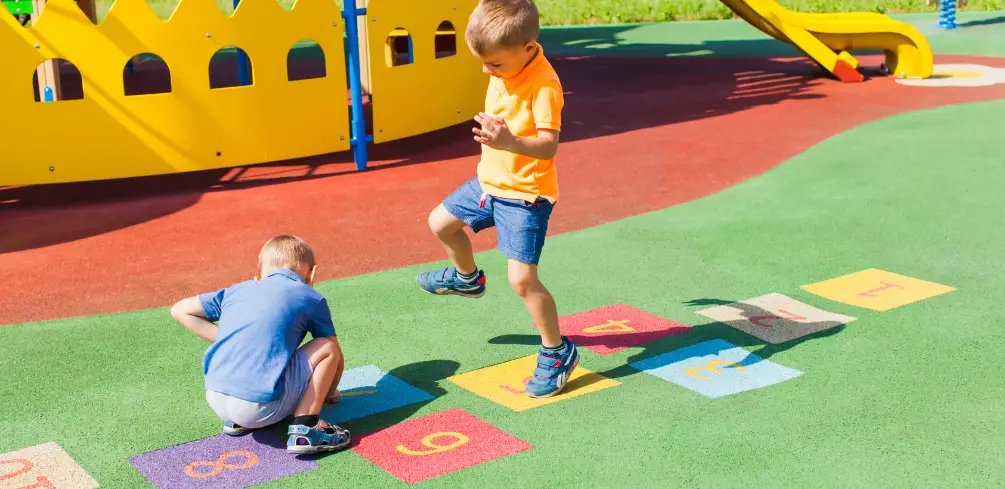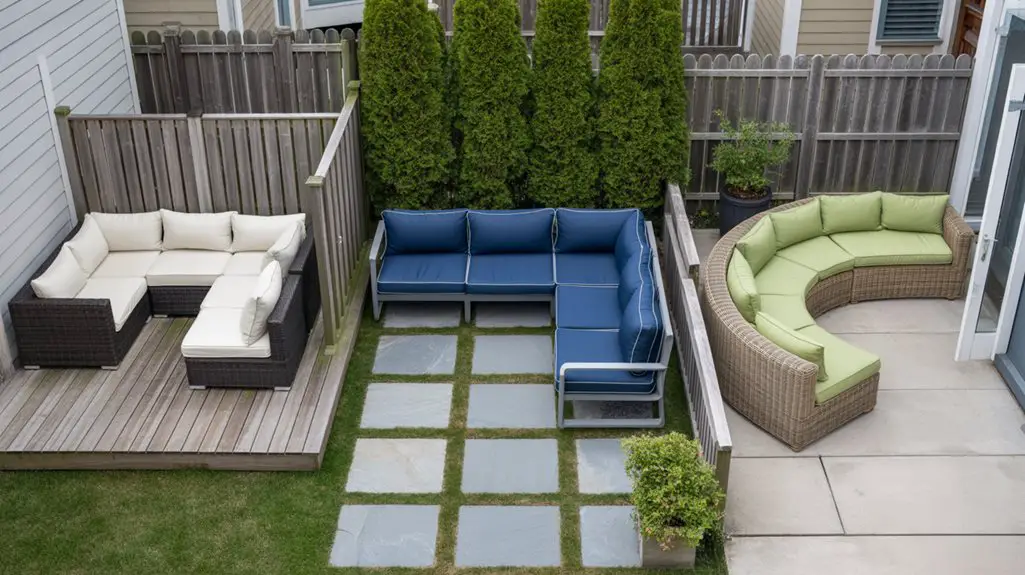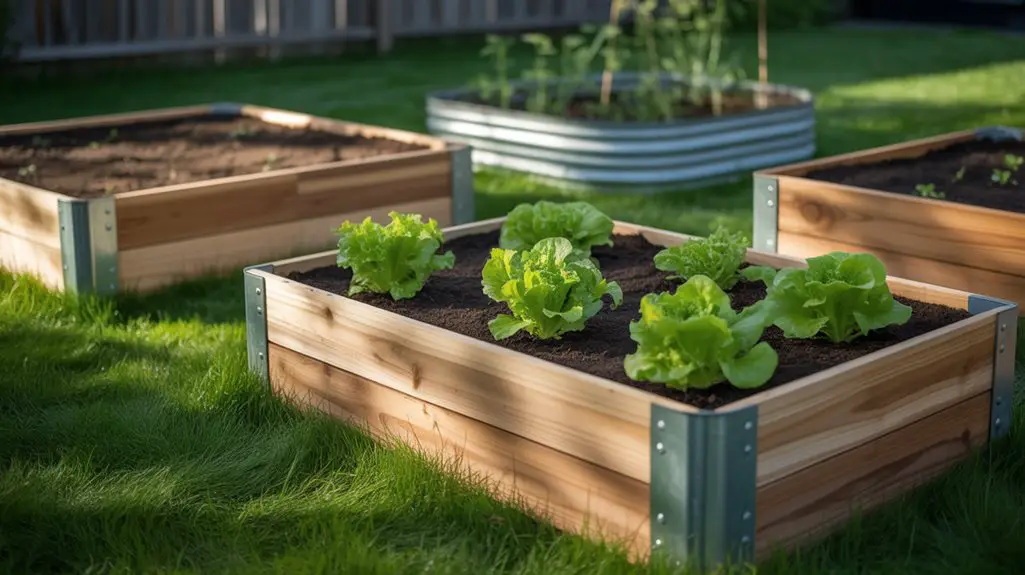Remember the good old days when a simple patch of dirt suffices as a playground surface?
Times have changed, and so have our standards for safety and comfort.
Now, you’re tasked with choosing the right ground material for your kid’s play area.
It’s not just about finding something fun and colorful anymore. Safety is paramount; you want to ensure the kids can fall, tumble and play without risking serious injury.
You also need to consider factors like maintenance and longevity – after all, playgrounds are meant to withstand countless hours of energetic activity.
Key Takeaways

- Safety and comfort are important factors when choosing playground ground material.
- Wood chips offer a natural look and excellent cushioning for falls.
- Rubber tiles and mats provide excellent shock absorption and have a non-slip surface.
- Artificial turf has lower maintenance needs, is highly durable, and provides consistent protection.
Evaluating Ground Material for Safety and Comfort
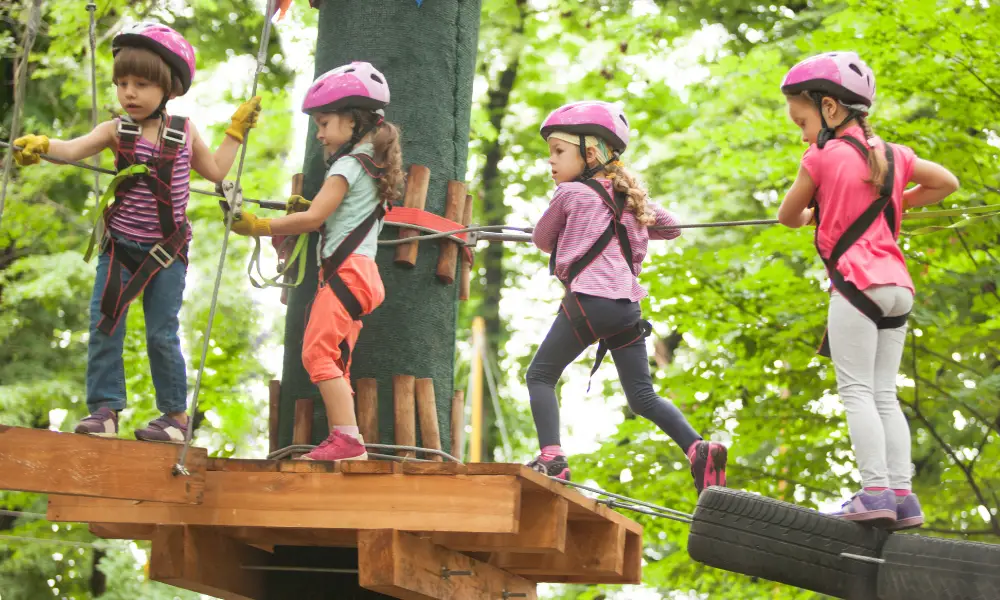
You’d surely want your child to play with peace of mind; knowing the ground beneath their feet offers both comfort and safety.
As a conscious guardian, it’s important to evaluate the playground ground material not only based on its impact on your little one but also considering its effect on the environment.
Pea gravel, rubber mulch, wood chips, or sand; each comes with its own pros and cons. Pea gravel is a popular choice due to its drainage capabilities and low maintenance cost. However, it’s harsh underfoot and poses a choking hazard for toddlers.
Rubber mulch can cushion falls effectively but raises concerns about toxic chemicals leaching into the soil.
Conducting a material cost analysis is equally crucial. While wood chips are cheaper initially, they require frequent replenishment, which could add up over time. On the other hand, poured-in-place rubber surfacing has higher upfront costs but promises longevity.
To strike that balance between safety, comfort, and freedom for children while being mindful of environmental repercussions and budget constraints isn’t easy.
Yet it’s vital in ensuring an optimal playground experience that doesn’t compromise our planet’s well-being or empty out your wallet unnecessarily.
Exploring Options: Mulch and Wood Chips

When it comes to outdoor play spaces, nearly 44% opt for mulch and wood chips as their go-to surface. But why is this so?
You may ask. Well, the reasons are not far-fetched.
Firstly, let’s look at mulch. Mulch sustainability is a big plus point here. Not only does it provide a soft landing for those inevitable tumbles, but also it’s environmentally friendly, being made from recycled organic material.
It decomposes over time, enriching the soil below – a definite win in the sustainability stakes.
| Material | Safety | Aesthetics | Sustainability |
|---|---|---|---|
| Mulch | High | Moderate | High |
| Wood Chips | High | High | Moderate |
Wood chips, on the other hand, offer an extra edge when talking about aesthetics. They present a more natural look that blends well with outdoor environments adding charm to your playground while still providing excellent cushioning for falls.
Remember though, both options require regular maintenance to ensure they retain their safety features and aesthetic appeal over time. So there you have it!
Two great choices, each with its unique advantages – now you’re set to make an informed decision based on what fits your needs best.
The Advantages of Rubber Tiles and Mats for Ground Material
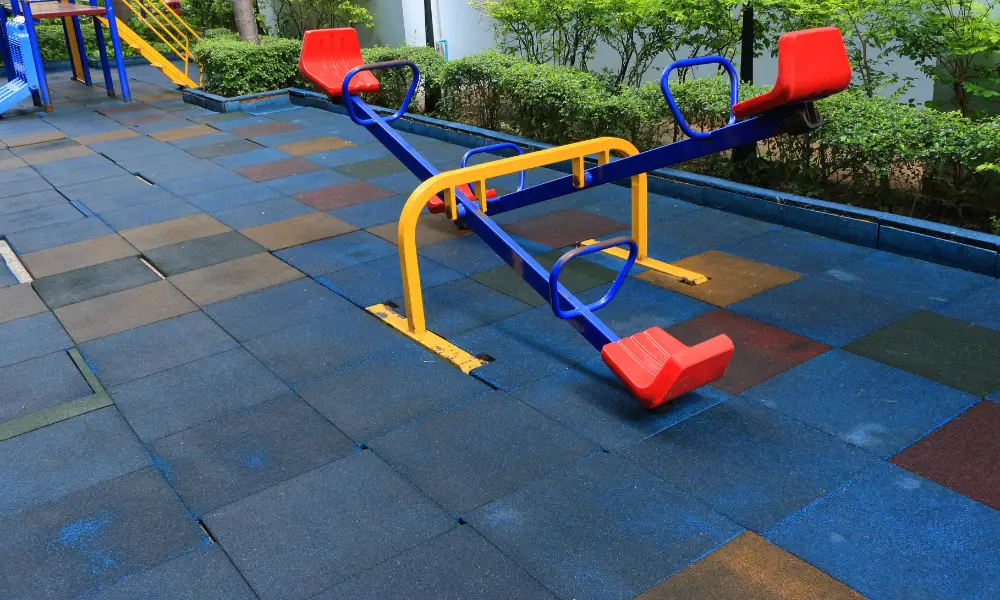
Let’s shift gears and delve into the world of rubber tiles and mats, an innovative solution that weaves safety, aesthetics, and sustainability into a playground’s canvas.
This modern material isn’t just about colorful patterns; it’s about incorporating Rubber Durability and Tile Versatility for a child-safe environment.
Rubber tiles are built to last. They resist wear and tear better than other materials—you won’t need to replace them frequently, saving you time and money in the long run.
Their durability can withstand all sorts of weather conditions, making them a reliable choice for any climate.
But it doesn’t stop there; tile versatility adds another layer of benefit. You have freedom in design with an array of colors and shapes available—whether you want to mimic nature or create an abstract mosaic is entirely up to you!
Safety-wise, these rubber mats provide excellent shock absorption, reducing the risk of injuries from falls—a crucial feature considering children’s adventurous spirit on playgrounds. The non-slip surface also ensures they stay upright while running around gleefully.
Consider this option next time you’re scouting for playground ground materials. Rubber tiles’ resilience, combined with their immense versatility, makes them a worthy contender in this space!
Gravel and Sand: Pros and Cons
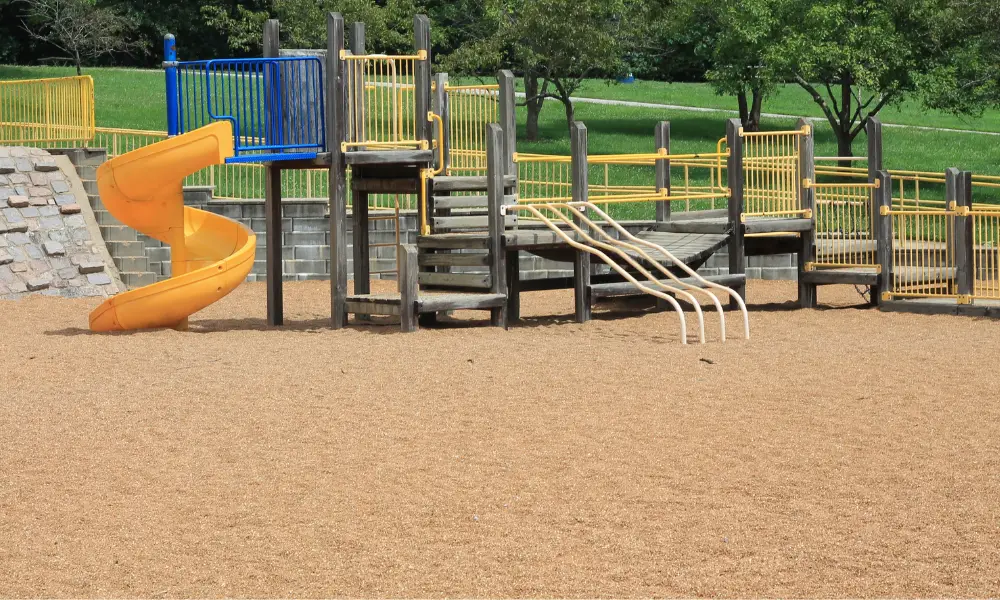
Shifting your attention to gravel and sand, there’s an old-school charm about these options that might pique your interest.
Both materials have been used for playgrounds for decades and they each come with their unique set of advantages and disadvantages.
Here are four key points you should consider:
- Gravel aesthetics: Gravel provides a natural, rustic look that blends well with outdoor environments. It also comes in various sizes and colors, allowing you to customize the look of your playground.
- Sand compatibility: Sand is a great material for building structures like sandcastles as it can be easily compacted yet still remains loose enough to provide cushioning during falls.
- Maintenance: Both materials require regular raking and topping up to ensure safety levels remain high.
- Safety concerns: While both gravel and sand provide good shock absorption, small particles can pose choking hazards or get lodged in the eyes or shoes.
Taking all these factors into account, it’s clear that while gravel and sand may present some challenges, they also offer unique benefits, from the aesthetic appeal of gravel to the play opportunities offered by sand.
Consider carefully what suits your specific needs before making a decision on playground ground material.
Incorporating Natural Grass or Artificial Turf
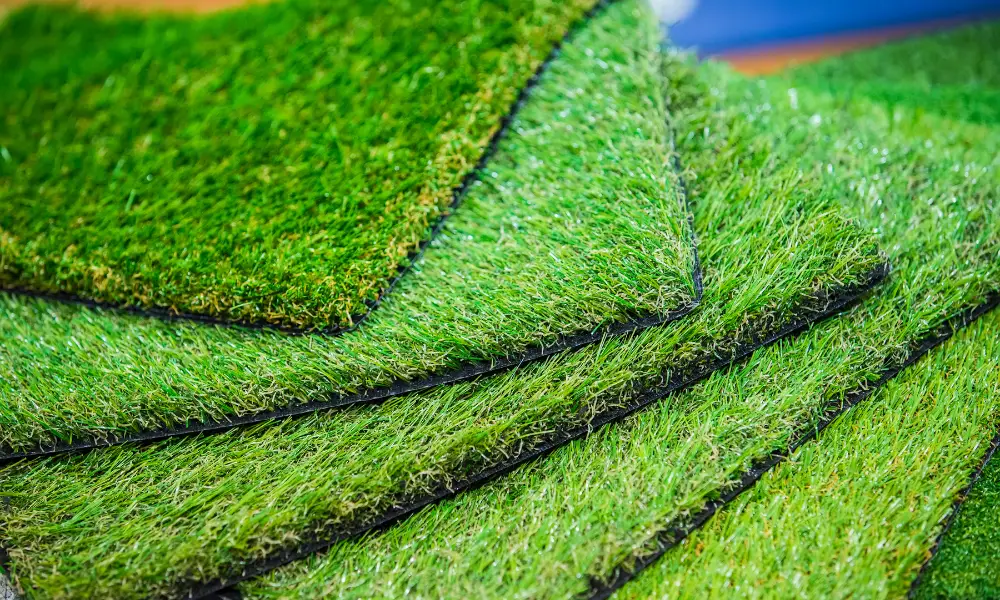
Delving into the domain of delightful greens, natural grass, and artificial turf tends to tempt with their lush, lively appeal.
These options not only add a touch of beauty and freshness to your playground but also offer an array of safety benefits. Understanding the differences between these materials is key to making an informed choice.
Here’s a quick comparison:
| Aspect | Natural Grass | Artificial Turf |
|---|---|---|
| Sustainability | High (Turf Sustainability) | Moderate |
| Maintenance | Regular watering, mowing & fertilizing | Minimal |
| Allergy Risk | High (potential for Grass Allergies) | Low |
| Durability | Can wear out in high-traffic areas | Highly durable |
| Cost | Lower initial cost | Higher initial cost; lower maintenance cost |
The freedom to play without concern for injury is paramount. While both options provide cushioning during falls, artificial turf may provide more consistent protection as it doesn’t wear down or develop hard patches like natural grass might.
Choosing between natural grass and artificial turf involves considering several factors, including potential allergies, upkeep requirements, sustainability concerns, and the overall costs involved.
Remember that creating a safe, inviting environment is always worth the investment in our children’s growth and development.
Maintenance and Longevity Considerations of Playground Ground Material

When it comes to keeping your kid’s play zone spick and span, there’s more than meets the eye! It isn’t just about cleaning; you must think about material durability as a part of maintenance as well.
Choosing the right playground ground material isn’t just about what feels good underfoot or looks appealing. You need something that can withstand weather conditions and heavy use and still remain safe for your children. Therefore, cost efficiency should be considered within this context.
Sure, natural grass may be cheaper initially, but it will require constant watering and mowing, which may add up over time.
On the other hand, artificial turf might seem costly at first but could prove less expensive in the long run due to its low maintenance needs. No mowing or watering is required here!
Plus, it doesn’t wear out easily, so replacement costs are minimized.
Material durability also impacts your child’s safety directly. A worn-out surface becomes hazardous quickly, leading to trips and falls.
So when maintaining your playground ground material, remember that longevity is key for both safety and savings.
Just keep these factors in mind while making decisions on playground materials – it’s all about balancing initial costs with ongoing maintenance expenses and ensuring safety always comes first!
Conclusion
As you watch your child’s laughter echo across the playground, remember that their joy is rooted in safety. Whether nestled on mulch, bouncing on rubber mats, or running through grassy plains – every choice made for ground material carries weight.
Keep comfort, maintenance, and longevity in mind when finding the perfect fit for your little adventurer’s playtime paradise. After all, there’s nothing quite like seeing them thrive in an environment where they’re safe to explore and grow.

